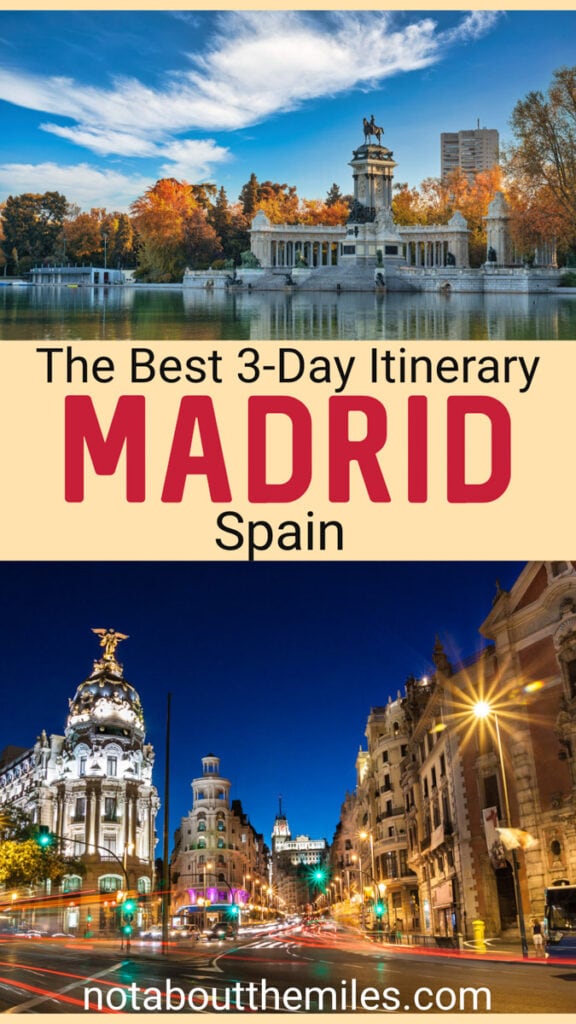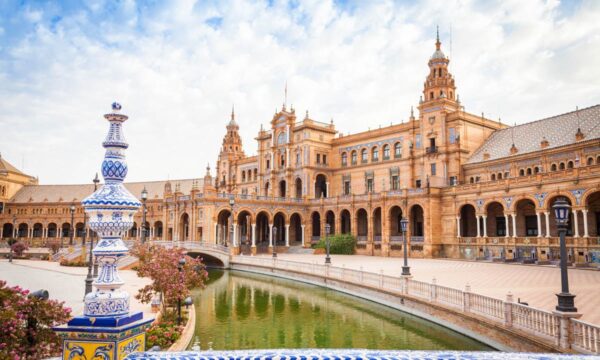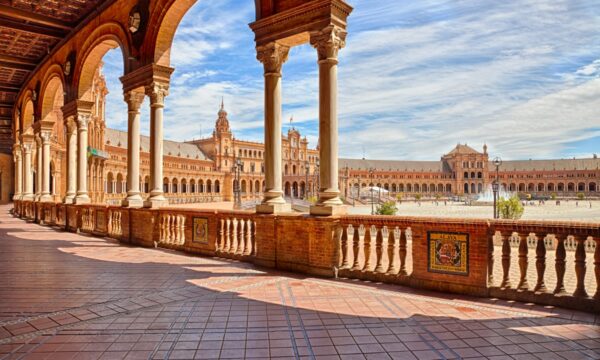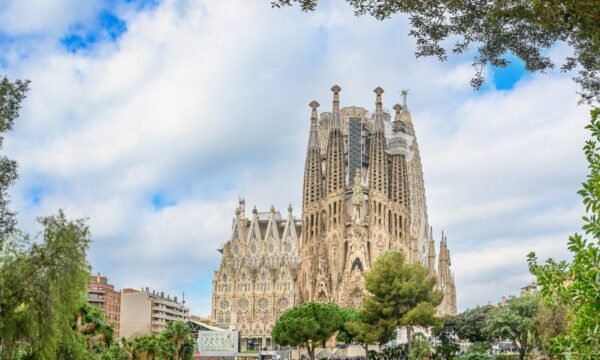Planning a trip to Madrid, Spain? Our 3 days in Madrid itinerary offers the perfect first look at Spain’s capital city.
International visitors sometimes pass over Madrid in favor of Barcelona or the cities of Andalusia, but if you enjoy walkable historic centers with a variety of sightseeing options and great food, definitely plan on at least 3 days in Madrid!
The city’s Golden Triangle of Art, made up of three superb art museums, is reason enough to spend a few days here, but Madrid’s magnificent Royal Palace, gorgeous gardens, verdant parks like El Retiro, and many vibrant neighborhoods are additional reasons to visit.
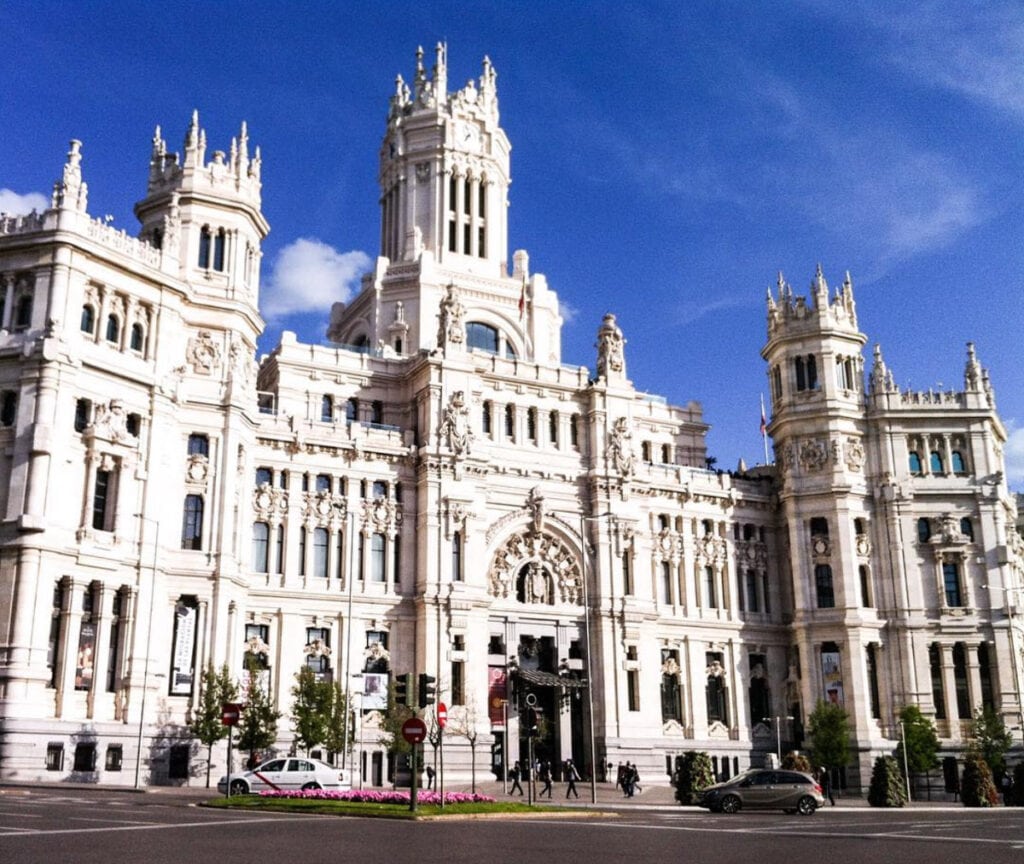
Some links on this page may be affiliate links. If you click an affiliate link and make a purchase, we may receive a small commission, at no extra cost to you. For more details, refer to our disclosure.
There’s also an on-point entertainment scene, from traditional options like flamenco to music shows and cultural festivals.
And of course, the food is another irresistible draw. From Michelin star restaurants to streets lined with authentic tapas bars, and cafes known for their churros and chocolate, you’ll find a lot to tickle your taste buds in Madrid.
In Madrid you can enjoy drinks with a view at the many rooftop bars, do a tapas crawl in place of lunch or dinner, or dine at the oldest restaurant in the world.
Whatever your travel style, you will find fun things to do during your three days in Madrid!
In this 3-day Madrid travel guide, you’ll find a day-by-day itinerary for the best things to do in Madrid in 3 days, along with our suggestions for where to stay in Madrid, suggestions for eateries, and the best time to visit.
Excited? Let’s get started discovering the perfect 3 days in Madrid itinerary!

IN THIS ARTICLE…
The Best 3 Days in Madrid Itinerary
Getting to Madrid
Getting Around in Madrid
Where to Stay in Madrid
The Best Time to Visit Madrid, Spain
Frequently Asked Questions
The Ultimate 3-Day Itinerary for Madrid
Day 1 of Your 3 Days in Madrid
Today, the first of your 3 days in Madrid, you will spend much of your time at the Royal Palace and its gardens, but you’ll also stroll some of Madrid’s famous plazas and get to sample some of the delicious local cuisine on a tapas tour!
Get some Churros and Chocolate!
If you are as fond of chocolate as we are, Chocolatería San Ginés is the perfect first stop on your Madrid itinerary.
The historic cafe has been serving up the much-loved combination since 1894, and you can’t research things to do in Madrid without coming across a mention of their chocolate and churros.
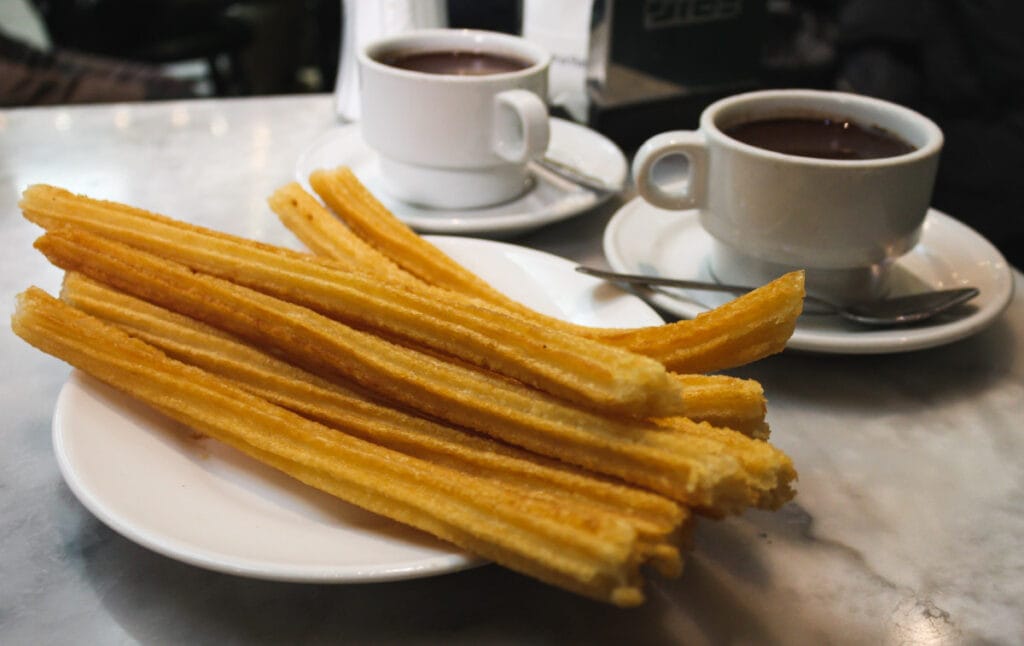
If you aren’t up for chocolate early in the day, you can opt for coffee and a pastry instead, and plan to return at night for the decadent chocolate: the cafe is open 24 hours from Thursday to Sunday and from 8 a.m. until 11.59 p.m. other days.
Walk Plaza Mayor
A stunning historic square in the heart of the oldest part of Madrid, Plaza Mayor is a must-stroll and one of the top places to see in Madrid.
Early in the day is when you’ll see it least crowded, if you want to admire the beautiful facades, snap photos, and enjoy a quiet stroll.
Later in the day Plaza Mayor offers excellent people watching and street performances to enjoy. You’ll see artists working, and locals and visitors soaking in the ambience.
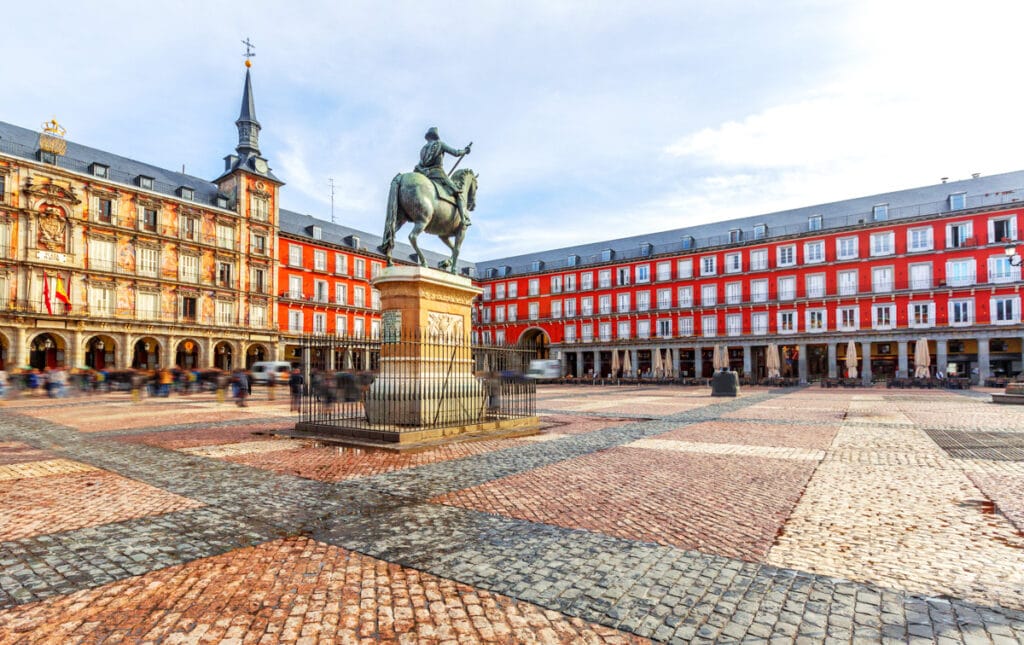
There are lots of eateries on the periphery of the plaza, if you want to relax for a bit and enjoy a cup of coffee.
The rectangular plaza was first built in the 17th century by King Philip III, at the site of an existing plaza that used to host Madrid’s central market.
Ravaged three times by fires, Plaza Mayor war rebuilt each time, with the latest reconstruction completed in 1854.
Today’s Plaza Mayor is rectangular in shape, with beautiful architecture on the periphery and an equestrian statue of King Philip III in the center. The statue, created by Giambologna, was a gift from the Duke of Florence.
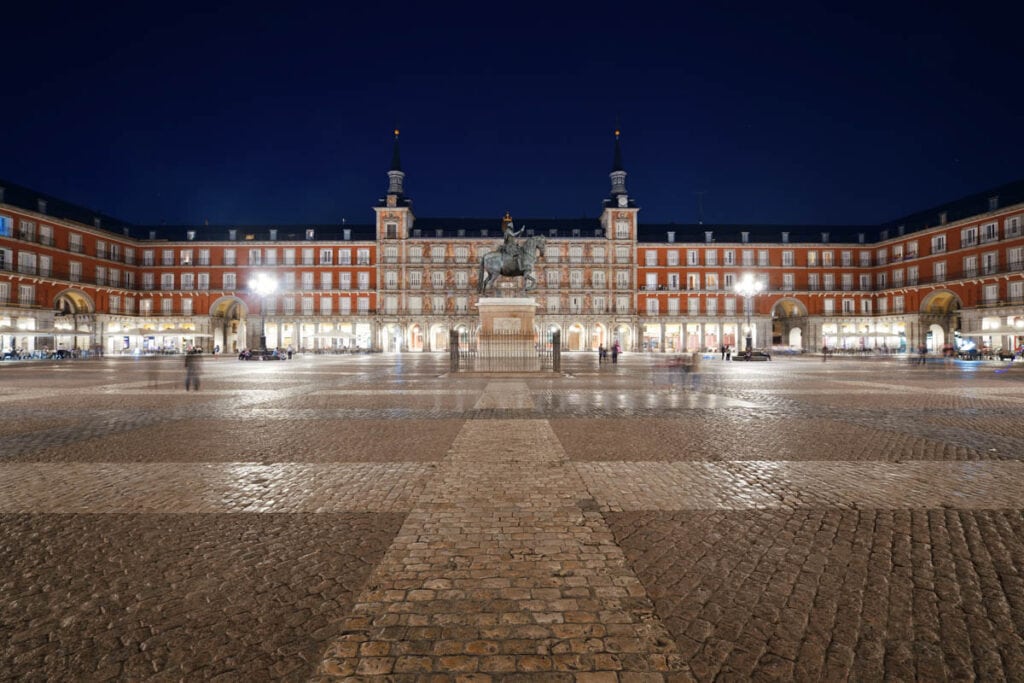
The Casa de la Panaderia is the large Baroque building to the north of the plaza, flanked by two towers. Admire the many murals on the facade.
The plaza hosts Madrid’s Christmas Market, if you plan to visit during the holidays, and a drum parade at Easter.
Explore the Royal Palace of Madrid
The Royal Palace of Madrid is one of the city’s top attractions, and the main focus of day 1 of your 3 days in Madrid itinerary.
With an imposing exterior and a lavish interior with lots of art and fine furnishings, the palace is a must-explore!
Although it’s no longer the home of the royal family, the magnificent Royal Palace of Madrid still functions as their official residence and is used for state ceremonies and events.
It is one of the largest royal palaces in the world!
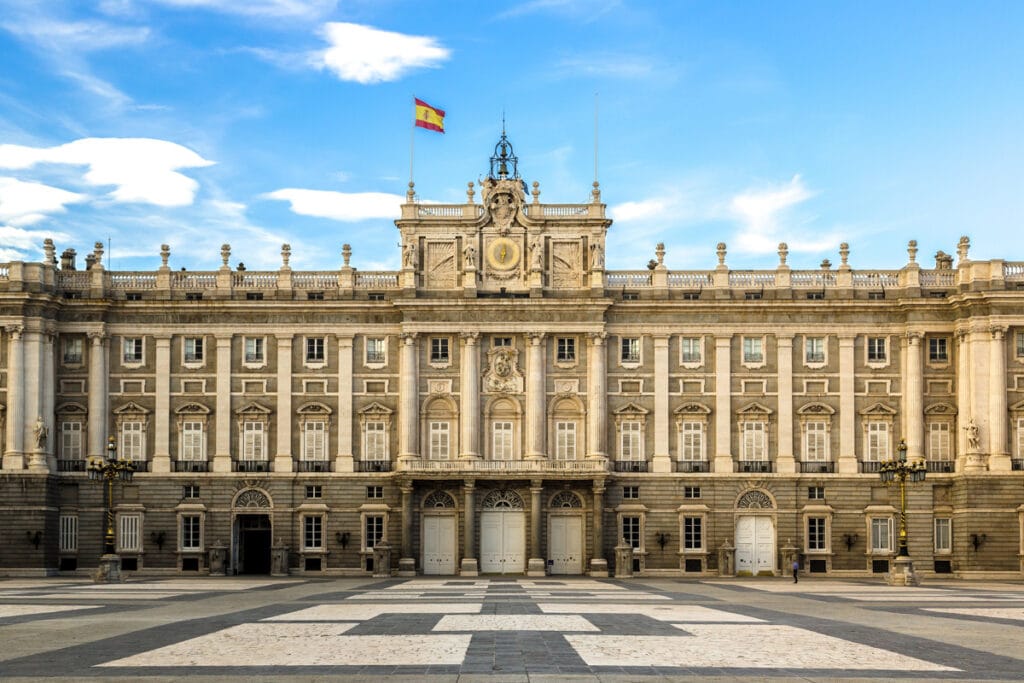
Built at the site of a medieval fortress, the current palace was initiated in 1738 and completed seventeen years later. It served as the residence for many Spanish monarchs, from Charles III to Alfonso XIII.
The square Baroque palace is the largest in Europe, with more than 3,400 rooms. The main facade of the palace looks out onto the Plaza de la Armeria.
Some of the must-visit spots in the palace include the Throne Room, with a ceiling painted by Tiepolo, the Gasparini Room, with its floral decoration, and the Royal Chapel, which houses musical instruments by Antonio Stradivari.
The Royal Armory, with its massive collection of weaponry and armor, is considered the foremost in Europe, along with the armory in Vienna.
The main staircase is impressive, with 70 steps.
Look for art masterpieces such as Salome with the Head of John the Baptist by Caravaggio and White Horse by Velazquez.
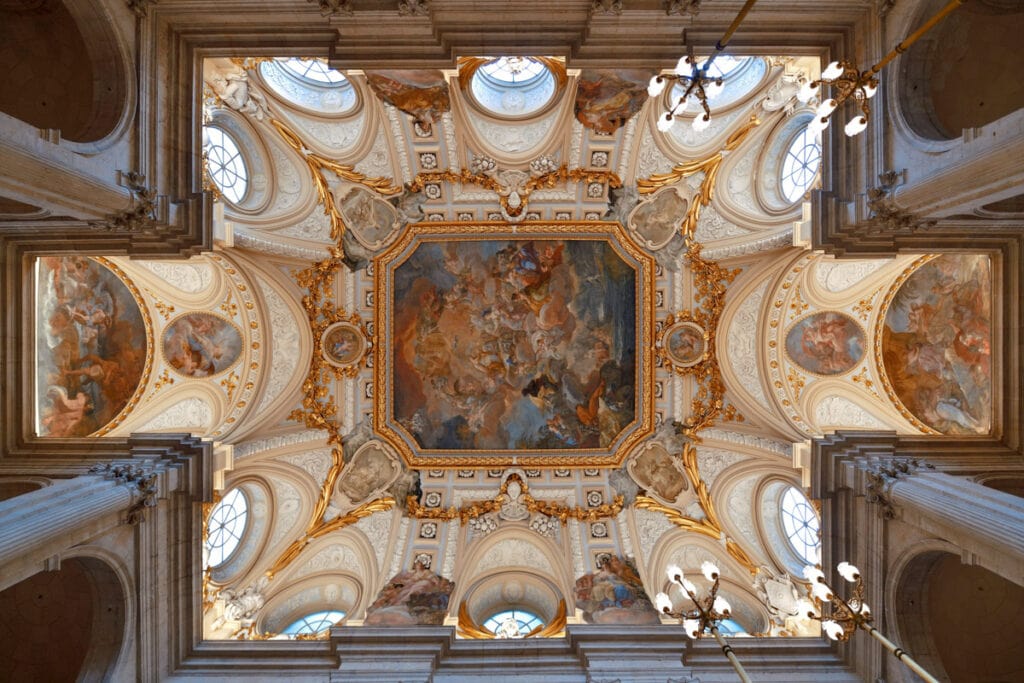
The Royal Kitchen can be viewed with a separate ticket. The kitchens are said to be among the best-preserved royal kitchens in Europe and were renovated just a few years ago.
Only a portion of the palace is open for viewing at any one time, and the tour route changes from time to time.
If you plan to visit independently, buy tickets at the official website ahead of time to secure the date and slot you want.
If they are sold out, you can also buy skip-the-line tickets at GetYourGuide.
We visited on a guided tour, and felt it was definitely worth the money to enter before the general public and learn about the history and context of what we were seeing.
This popular tour gets rave reviews. The 2-hour tour is led by an expert guide, and you can pick your language, English or Spanish.
If you have the Go City Madrid All-Inclusive or Explorer pass, a guided tour of the Royal Palace is included, along with many other attractions!
Take in the View from the Mirador de la Cornisa
In between the Royal Palace and the Almudena Cathedral, you’ll find the Mirador de la Cornisa, an observation deck that offers great views of the Campo del Moro Gardens and the Casa del Campo Park.
It’s a great place to stop for some photos!
The observation deck is free to enter, and is open from noon until 10 p.m.
Have lunch at the Mercado de San Miguel
Just a short walk away is the Mercado de San Miguel, one of the oldest markets in Madrid. It receives several million visitors each year and is a must on any first-time Madrid itinerary!
The glass and cast iron architecture is stunning, and inside you’ll find lots of stalls to browse.
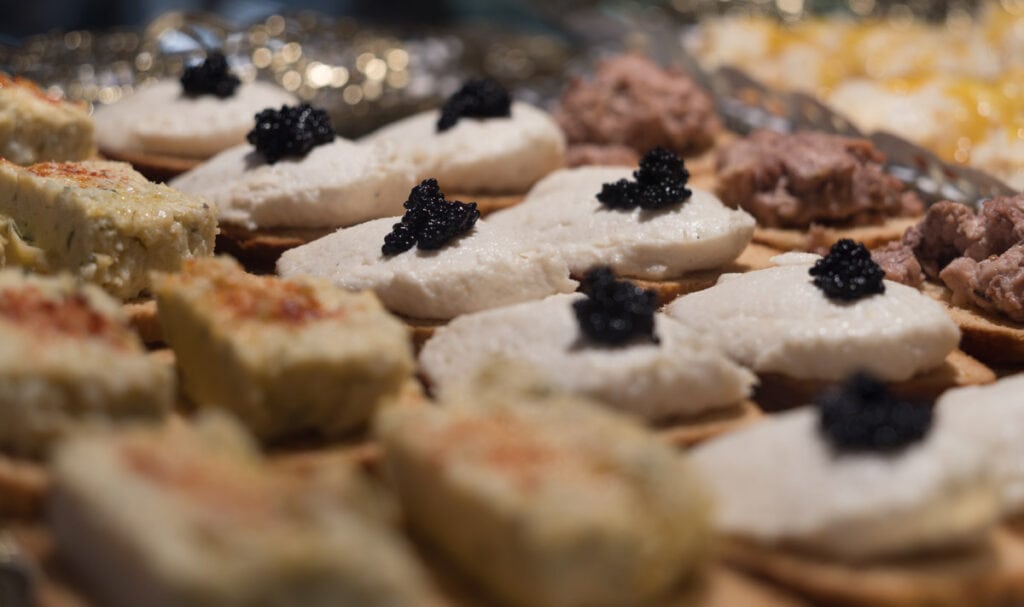
It’s the perfect place for lunch, although be prepared to brave crowds. Time your visit for off-lunch hours so you can find a table more easily.
While you’ll find stalls that sell meats and produce or fruit, you’ll also find a variety of prepared foods, jamon, cheeses, olives, cakes and pastries, and artisanal ice cream, fresh-squeezed juices, wine, and more.
Prices here are higher than you’ll find at other Madrid markets, but the location is super convenient. You’ll love the food, and the ambience is lively as well.
Visit the Almudena Cathedral
La Catedral de la Almudena was only consecrated in 1993!
The cathedral features a Baroque exterior, with twin towers. The interior is neo-Gothic, and the chapels uniquely modern.
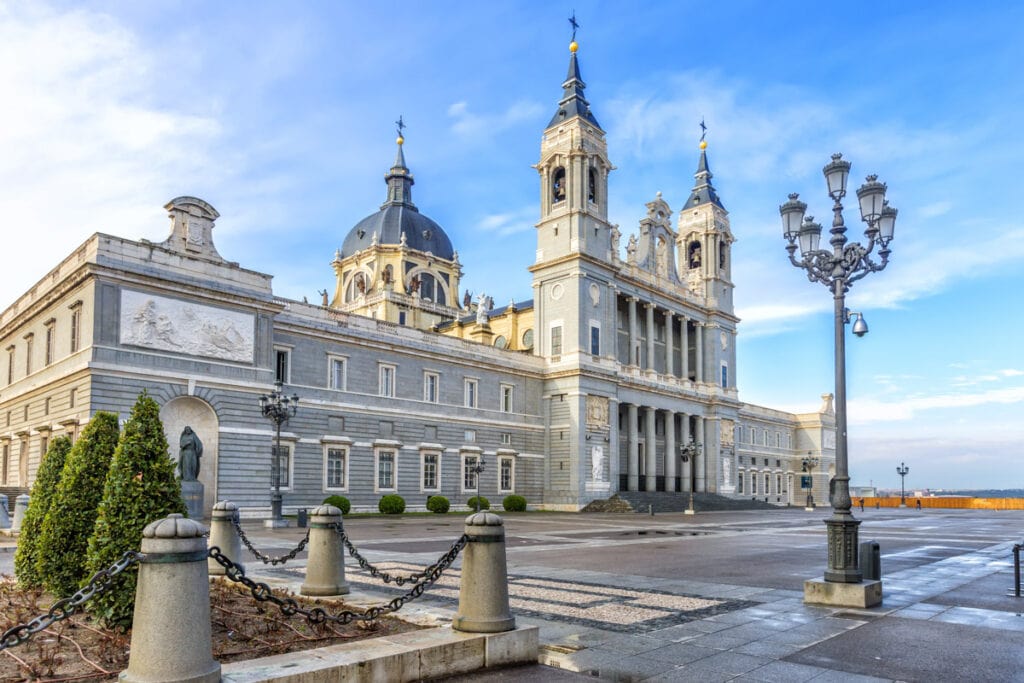
Although the original plans for a church were created in 1879, a few years later it was decided to build a cathedral rather than a church, and a more complex project was started.
A Gothic structure was designed but never came to fruition because of paucity of funds, and although the crypt was completed in the early part of the 20th century, it was only in 1950 that work started on the rest of the cathedral, to a new design.
The cathedral was ultimately completed in 1993.
The crypt is the largest in Spain, and is a gorgeous Romanesque Revival structure with several hundred columns with decorated crowning capitals. Don’t miss the painting of the Virgen de la Almudena, considered the oldest image of the Virgin in Madrid.
Climb the 150+ steps to the top of the dome for spectacular views of the Royal Palace and its gardens, and the city.
The cathedral museum and the dome climb have a combined fee. The museum has shorter hours than the cathedral itself, currently 10 a.m. to 2.30 p.m. Monday through Saturday.
Stroll the Sabatini Gardens
The Royal Palace has two gardens, the Campo del Moro Gardens and the Sabatini Gardens.
On this itinerary, we suggest exploring the Sabatini Gardens, set out in front of the northern facade of the palace.
Located at the site of the erstwhile royal stables, the Sabatini Gardens date from the 20th century.
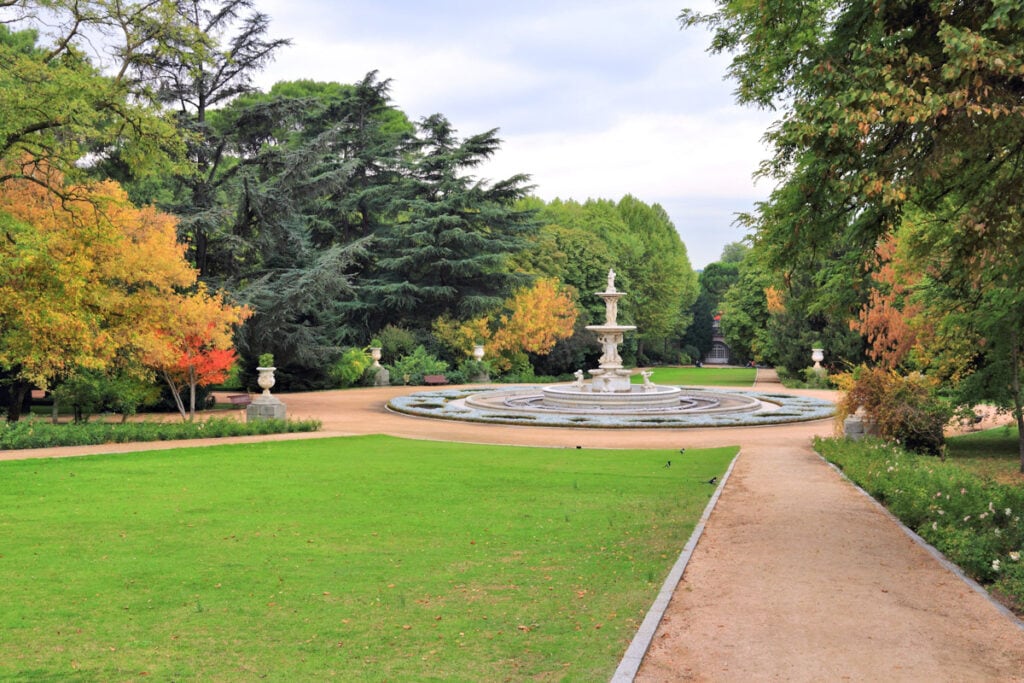
Split into three terraces, the neoclassical gardens feature formal hedges in geometric patterns, a large pool, and fountains and statues. You’ll find mature trees and different plantings to admire.
The gardens aren’t very large and make for a relaxing stroll.
The Campo del Moro gardens are much larger and less formal: more like a park. They have a separate entrance, which requires a bit of a walk. Since you’ll be visiting Retiro Park, we suggest skipping the Campo del Moro Gardens with just 3 days in Madrid.
Both gardens are free to enter.
Enjoy the Plaza de España
One of the many beautiful squares in Madrid, the Plaza de España is a lovely walk, with lots of beautiful trees and paths for both pedestrians and cyclists, but no automobile traffic.

Holding pride of place in the plaza is the Monument to Cervantes, with a lovely fountain at its base. Stop to snap a photo of Don Quixote and Sancho Panza!
There are two other fountains in the plaza.
In the winter, the square hosts a Christmas market and an outdoor ice rink.
Also admire the Torre de Madrid and the Edificio España, two of Madrid’s signature skyscrapers that flank the square.
Admire the Temple of Debod
Did you know you can visit an ancient Egyptian temple in the heart of Madrid?
Gifted to Spain by the government of Egypt when the Aswan Dam was constructed, the Temple of Debod dates back to the 2nd century B.C.
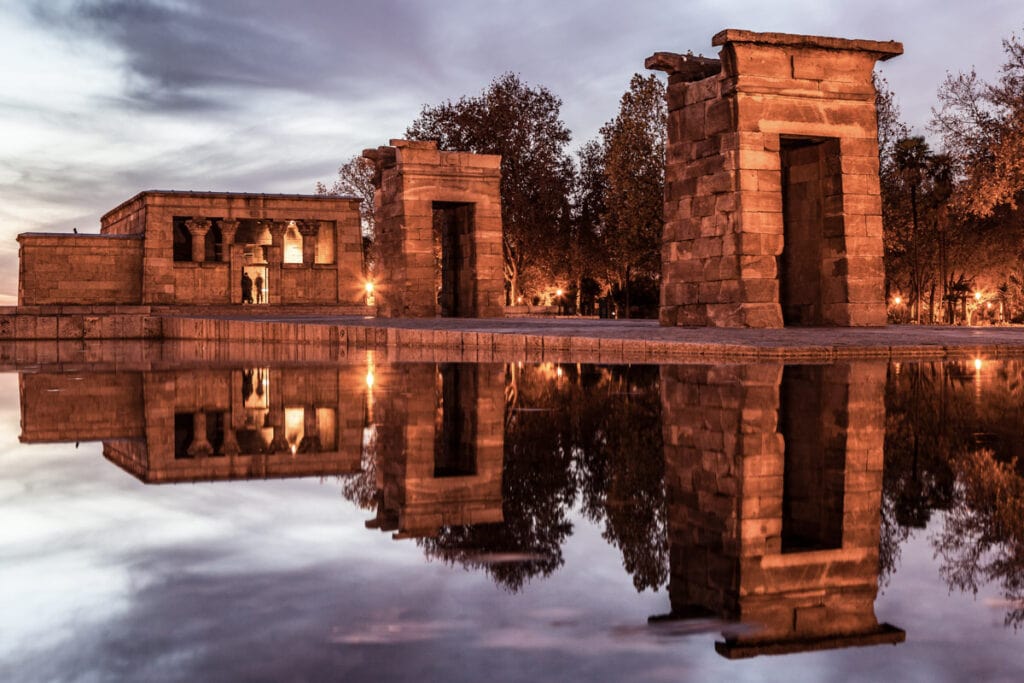
The original chapel was dedicated to Amun and Isis, with other structures built around it later. The Romans contributed to the decoration of the building.
When the region converted to Christianity, the temple was abandoned.
The complex of structures was transported to Madrid and reconstructed stone by stone at its new location.
The Temple of Debod and its gardens have been open to the public since the early 70s. It is a favorite sunset spot in Madrid!
The temple complex is free to visit.
End your day with a Food Tour!
A tapas crawl is the perfect way to end the first of your 3 days in Madrid!

Not only will you get to sample some tasty tapas at highly-rated eateries, you can also get recommendations from your guide on where to eat the rest of your time in the city.
You’ll try favorites like jamon iberico, salted cod, and chickpea stew, along with Spanish wines, but you may also taste some new-to-you tapas.
This highly-rated tapas and wine tasting tour is limited to a maximum of 12 participants, for an elevated experience.
Day 2 of Your 3 Day Madrid Itinerary
Today the renowned Prado Museum will be the highlight of your morning, and you’ll spend the afternoon exploring the beautiful Retiro Park, Madrid’s famous green space. Wrap up the sightseeing day with a stroll along Gran Via, Madrid’s most famous street.
Stroll Puerta del Sol
Start your second day in Madrid with a stroll through another historic square: the Puerta del Sol.
The semi-circular square is famous for the statue of the bear and the strawberry tree (El Oso y El Madroño), the official symbol of the Spanish capital. Posing for a photo by the statue is one of the most fun things to do in Madrid!
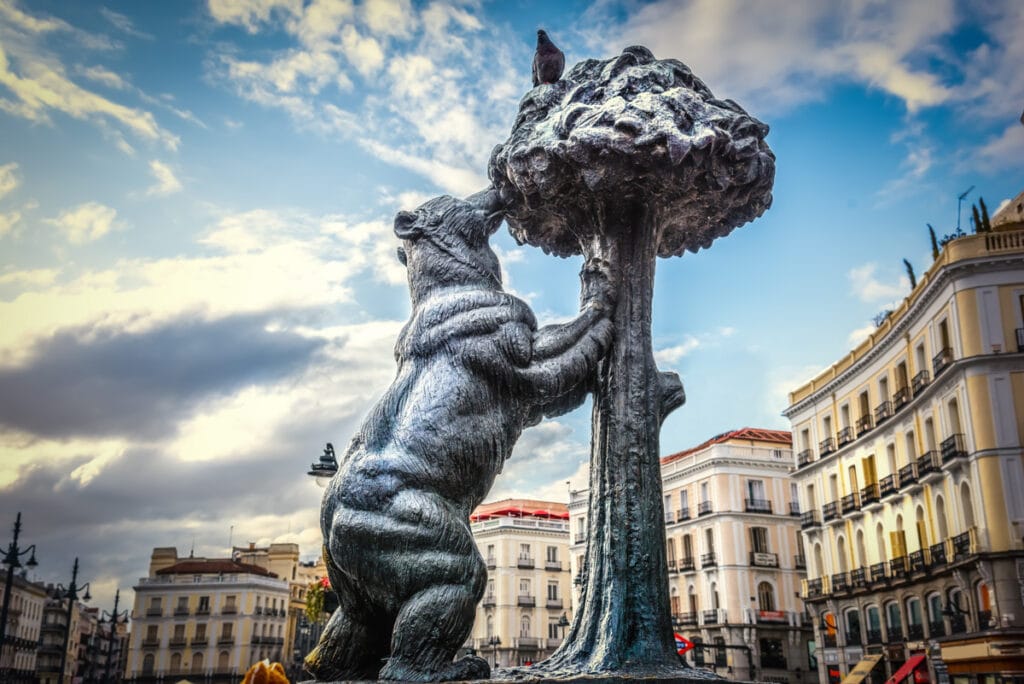
Also in the square you will find Kilometre 0, a stone slab that marks the geographical center of Spain. It is starting point of all the major radial roads in the country.
Look for the slab on the pavement outside the clock tower on the 18th century Real Casa de Correos, the old Post Office building.
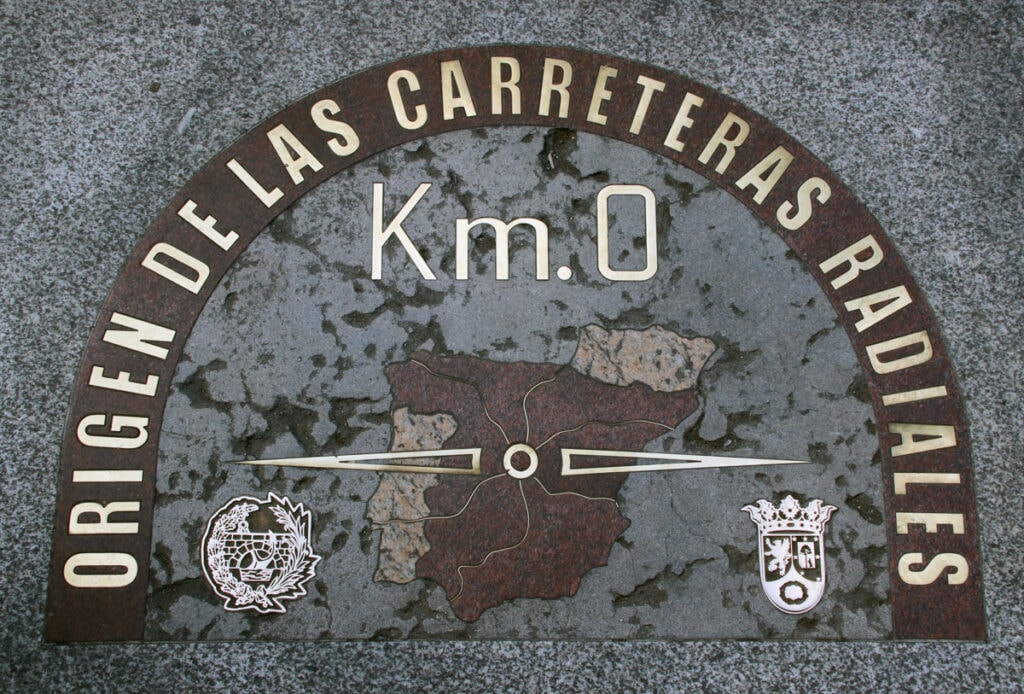
Madrileños count down the chimes of midnight on New Year’s Eve by the clock on this clock tower. So if you’re here then, arrive with twelve grapes, to eat one for each chime!
You’ll find other statues and monuments to admire in the square, including an equestrian statue of King Charles III, and it’s very busy and lively through the day.
Early in the day, however, you’re likely to find it much more peaceful, perfect for snapping photos and enjoying the architecture.
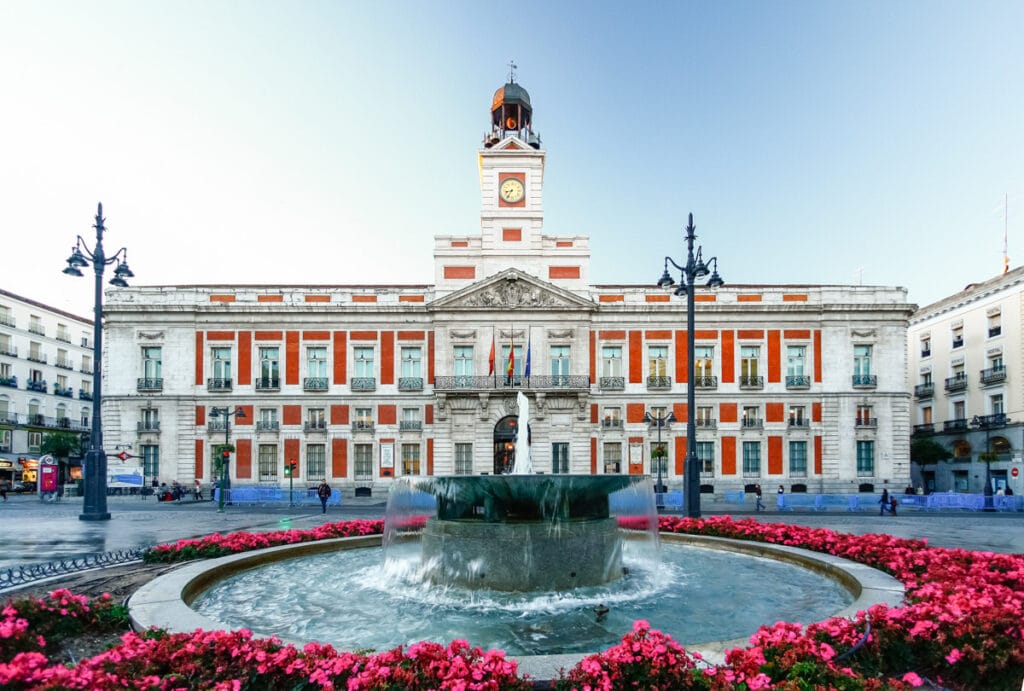
For a pastry and coffee, pop into La Mallorquina, a bakery that’s been operating in Madrid since 1894. Chocolatería San Ginés is also just a short walk away!
Take in the Art at the Museo del Prado
The Museo Nacional del Prado, often known simply as The Prado, is not just Spain’s pride and joy, it is also one of the best art museums you can visit anywhere in the world.
Art enthusiasts will drool over the collection of European art here, but even visitors with just a casual interest in art will be impressed by the volume and quality of the works on display.
In short, the Prado definitely deserves top billing on your 3-day itinerary for Madrid!
The Prado was set up in the early 19th century to display paintings and sculptures, but it also houses drawings, prints, and documents.
The museum is housed in a building designed by Juan de Villanueva, a famous Spanish architect, and built in the late 18th century.
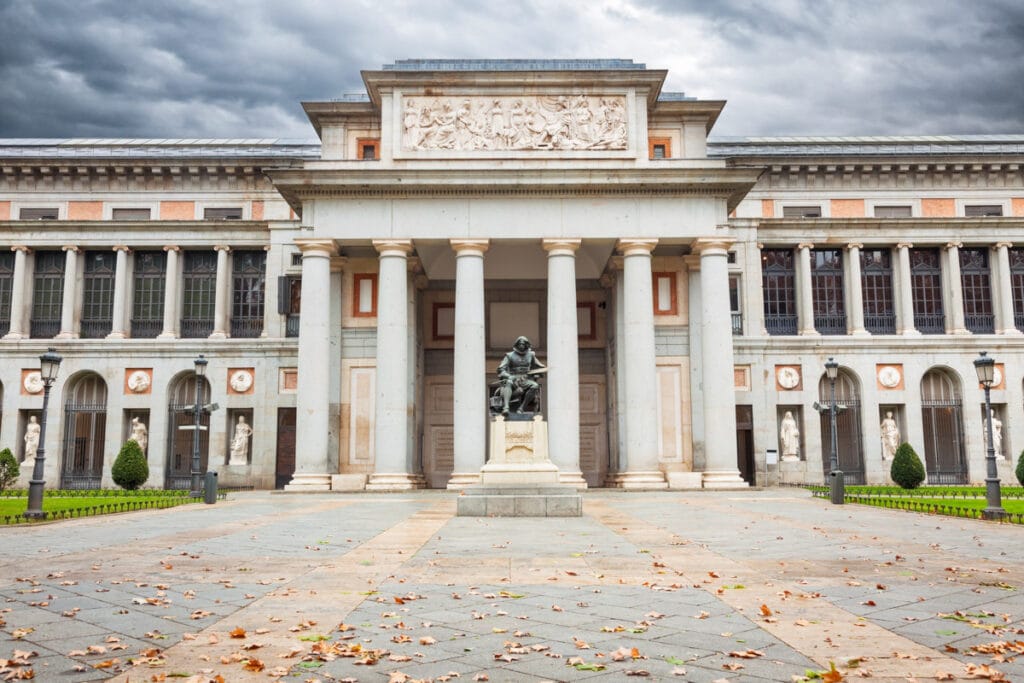
The massive collection of Spanish art in the museum includes works by Francisco Goya, El Greco, and Diego Velázquez. Artists from other countries include Titian, Peter Paul Rubens, and Hieronymus Bosch.
You’ll find Goya’s brooding “black” paintings here, as well as The Surrender of Breda and Las Meninas by Velazquez, and The Garden of Earthly Delights by Bosch.
Italian masters are well represented. Look for Andrea Mantegna’s Death of the Virgin, Raphael’s Portrait of a Cardinal and The Pearl, Caravaggio’s David and Goliath, and many more.
Photos and videos are not permitted inside.
The Prado opens at 10 a.m., and you should plan to be here at opening time. You can buy tickets online at the museum site. You can also buy skip-the-line tickets to El Prado on GetYourGuide .
Unless you are an art history expert, we highly recommend booking a guided tour of the Prado. It’s a very worthwhile investment, because not only will you not miss works of import (it’s a huge museum!), you will also get a lot of background information and context for the works you will see.
We find that a good guide can exponentially enhance our enjoyment of an art museum!
You can explore more of the art in the museum after completion of the tour.
Afterwards, walk over to The Spanish Farm for lunch. The food is delicious, crafted with local and seasonal ingredients, with a nice choice of wines.
Or opt for this guided experience, which combines a tour of the Prado with a VIP lunch at Botin, the oldest operating restaurant in the world! You’ll see the best works at the Prado with an expert guide and tour parts of Botin that visitors never see, including the kitchens.
Explore the lovely Retiro Park
Budget the greater part of the afternoon to explore Retiro Park. It’s lovely in every season!
Madrid is best known for its art museums and its parks, and Retiro Park is the crowning jewel in the city’s green spaces. Covering over 300 acres, Retiro Park is to Madrid what Central Park is to NYC.
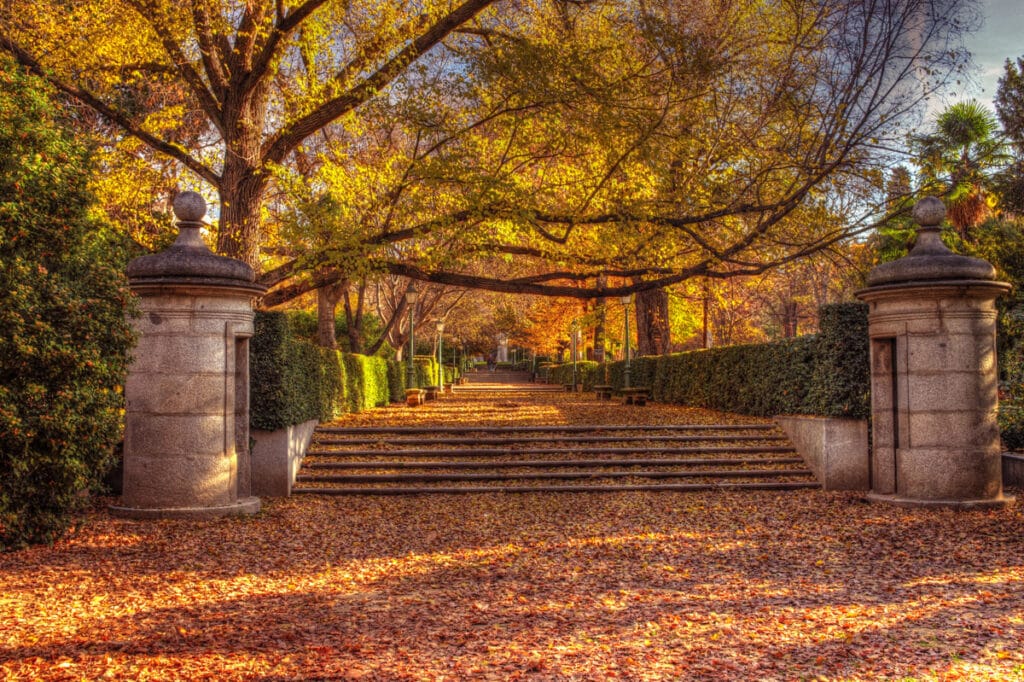
A UNESCO World Heritage Site, the park includes many monuments, fountains, and themed gardens, and you’ll find locals as well as visitors strolling, working out, or relaxing here.
Take a row boat out onto the large man-made lake, the Estanque Grande de El Retiro, and just walk the park to admire the thousands of mature trees and plantings.
In the Parterre Francés, you can view the Mexican evergreen that’s reported to be Madrid’s oldest tree.
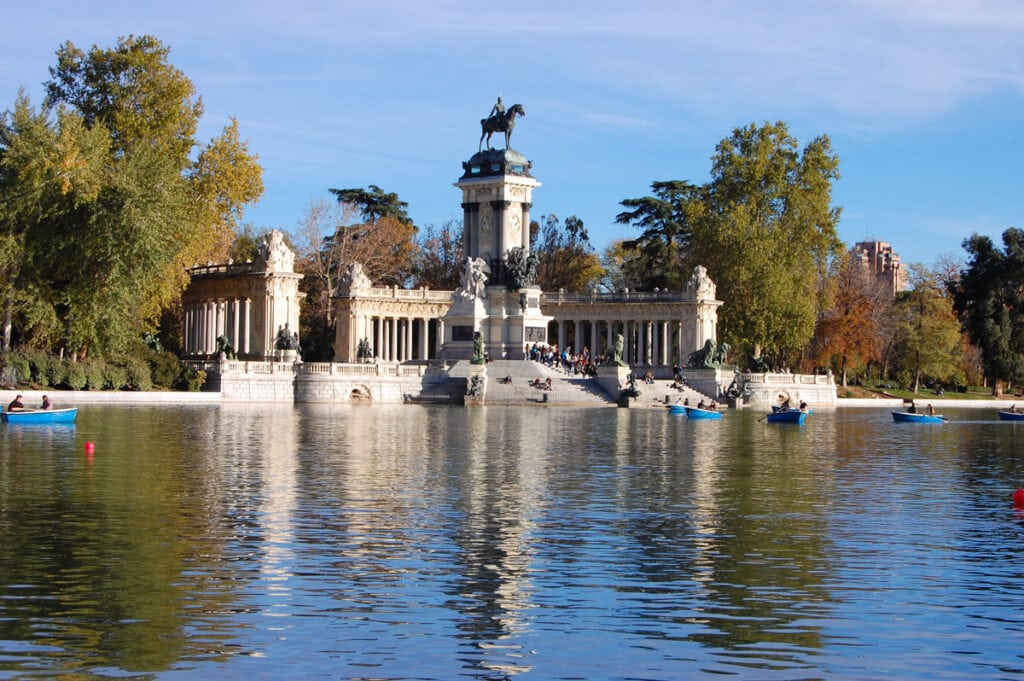
The Velazquez Palace in the park is currently an exhibition hall for the Reina Sofia Museum. The gorgeous building dates from the late 19th century and was built for an expo. Admire the lovely tile work on the facade.
The Glass Palace (El Palacio de Cristal) is an absolute must-visit in Retiro Park. Originally built to be a greenhouse, the palace is also currently an exhibition space for the Reina Sofia Museum.
The cast iron and glass structure features spectacular tile work by the same artist that decorated the Velazquez Palace, Daniel Zuloaga.
The Crystal Palace is free to enter.
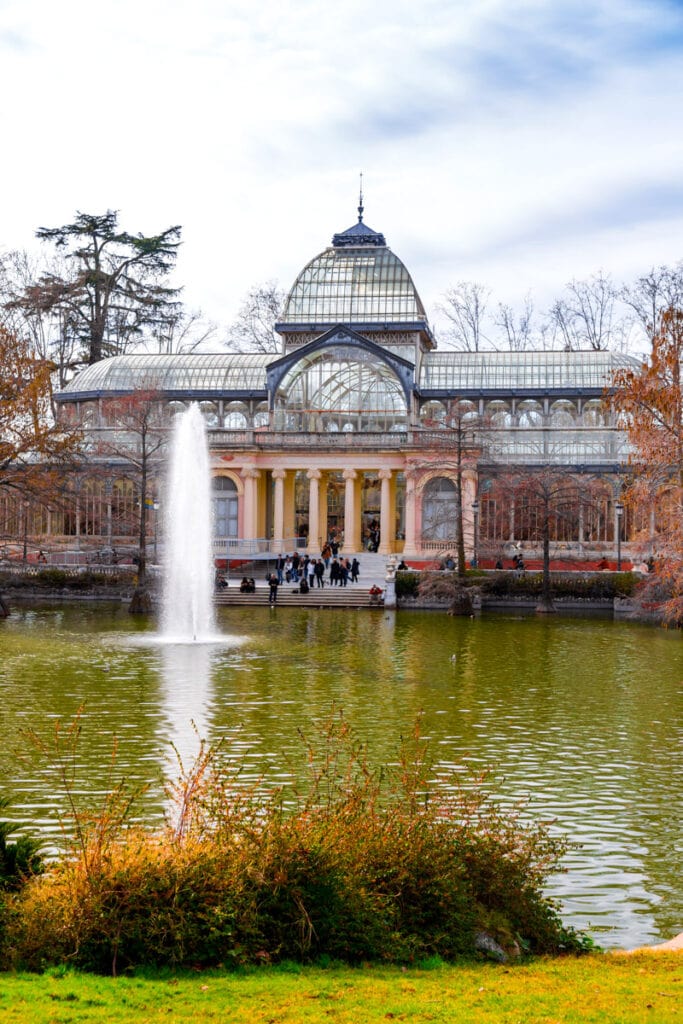
You’ll find numerous statues in Retiro Park, as well as ornamental entrances, and beautiful fountains.
The Monument to Alfonso XII is a famous spot, as is the Fuente del Ángel Caído.
During the day and in the evening, enjoy performances by street musicians as you explore.
If you visit in May or June, be sure to stroll the rose garden, which you are likely to find in peak bloom during these months.
And visit the Pabellón de los Jardines de Cecilio Rodriguez to see the peacocks! The garden is also beautiful to stroll.
Snap a photo of the Puerta del Alcala
Just outside Retiro Park, you’ll find the Puerta de Alcalá in the Plaza de la Independencia. The gate stands on an island, and is surrounded by busy streets, but you can walk over to view it closer.
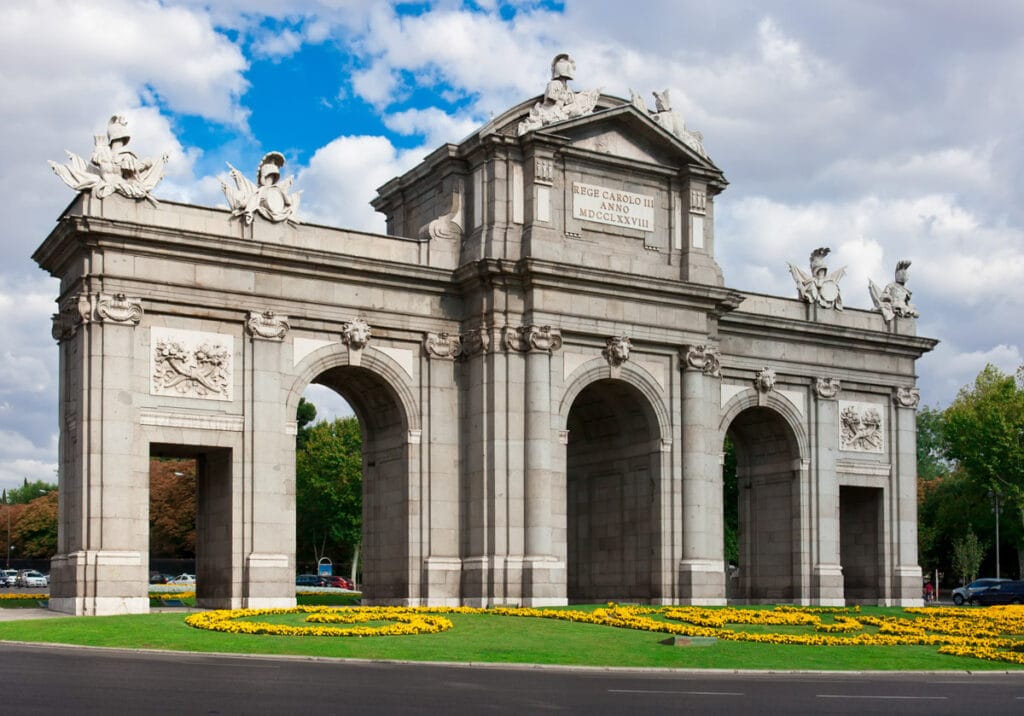
Built in the 18th century by King Carlos III, the gate once served as the main entrance into the city. The granite neo-classical gate features five impressive arches.
It’s a nice photo stop as you head over to your next sightseeing stop!
Visit the Plaza de Cibeles
One of the most famous squares in Madrid, the Plaza de Cibeles is home to stunning architecture and a fabulous fountain.
The square is one of the most photographed places in Madrid and makes for a great visit both by day and after dark, when the buildings and fountain are illuminated.
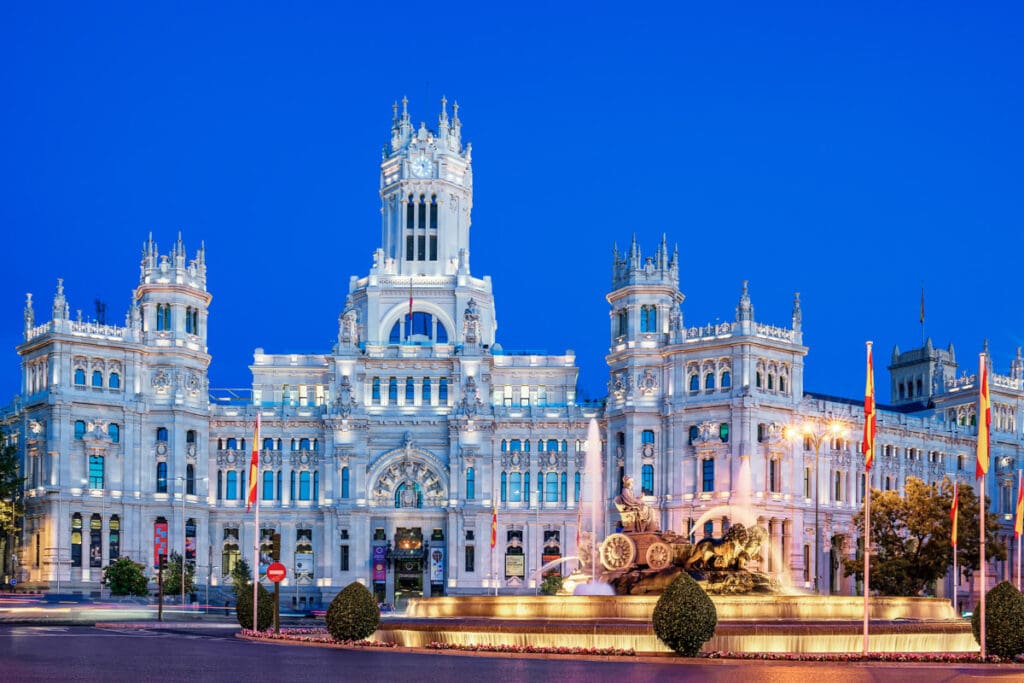
Admire the absolutely stunning Cibeles Palace, formerly the Palace of Communication and now home to the Madrid City Council.
The palace complex, with its pristine white facades and ornate embellishments, takes up one quarter of the periphery of the plaza.
In the square is the Fountain of Cibeles, another iconic symbol of Madrid. The neo-classical fountain features Cybele, a Phrygian goddess of fertility in a chariot drawn by two lions.
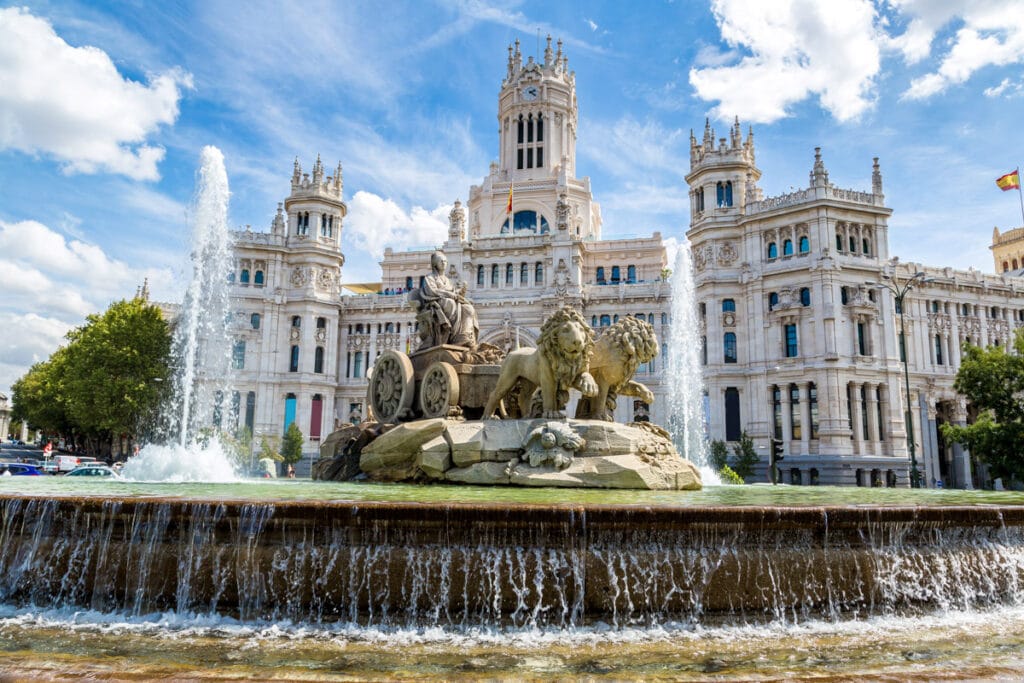
The other buildings around the square are the Bank of Spain building, the Palacio de Buenavista, and the Palacio de Linares.
Although the Cibeles Palace keeps you riveted, the other buildings are impressive as well!
Stroll the Gran Via
Now it’s time to stroll Calle Gran Via, one of the most impressive streets in the Spanish capital.
Admire the gorgeous architecture along the historic thoroughfare, browse the upscale shops, and enjoy the vibrant ambience. You’ll find lots of eateries and bars on the street, as well as some entertainment options.
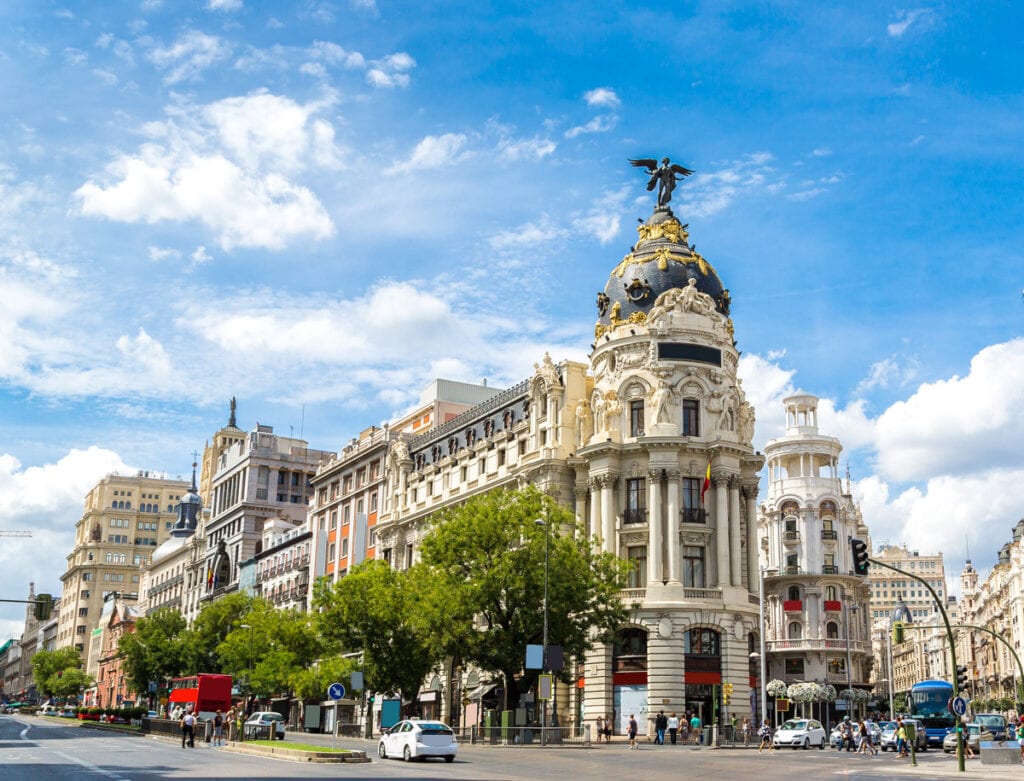
From Calle de Alcalá near the Plaza de Cibeles, the street ends at the Plaza de España, and is about a mile long, perfect for walking from end to end.
Admire the Metrópolis with its Corinthian columns and lavish gold accents. Edificio Grassy nearby looks like a tiered wedding cake. Together they form one of Madrid’s most popular photo spots.
Gaze up at the Telefónica building, once one of the tallest buildings in Europe.
The Art Deco Edificio Carrión is another iconic building to admire, with its famous neon Schweppes sign.
Walking the street after dark, when it’s all lit up, is a wonderful experience. There are sidewalks, so you can walk safely even though the street itself is busy.
Day 3 of Your Madrid Itinerary
You have many choices for your final day in Madrid, from more art museums and gardens to touring Madrid’s football stadium, or exploring some of the city’s vibrant neighborhoods.
You can also opt to explore near the capital city on a day trip or part day trip. While historic Toledo is one of the easiest day trips from Madrid you can take, you can also visit Segovia, Avila, and more.
On our first visit to Madrid, we spent our third day visiting the remaining two art museums from Madrid’s Golden Triangle of Art, interspersed with a stroll through the Royal Botanic Gardens. We also explored La Latina and watched a flamenco show in the evening.
We’ve described some choices below, from which you can craft Day 3 of your 3 days in Madrid!
And if you have more time in Madrid, these activities are definitely worth considering for your additional time in the city.
Explore Barrio de La Latina
Located in the oldest part of Madrid — at the site of the Islamic fortress that stood here inside the city walls — La Latina is known for its vibrant atmosphere.
The narrow alleys are perfect for wandering, and you can linger in the large squares lined with eateries.
If you enjoy churches, stop by the Iglesia de San Francisco el Grande (the dome is spectacular!) and the Iglesia de San Andres. The former is home to Goya’s St. Bernardino of Siena Preaching to Alfonso V of Aragon.
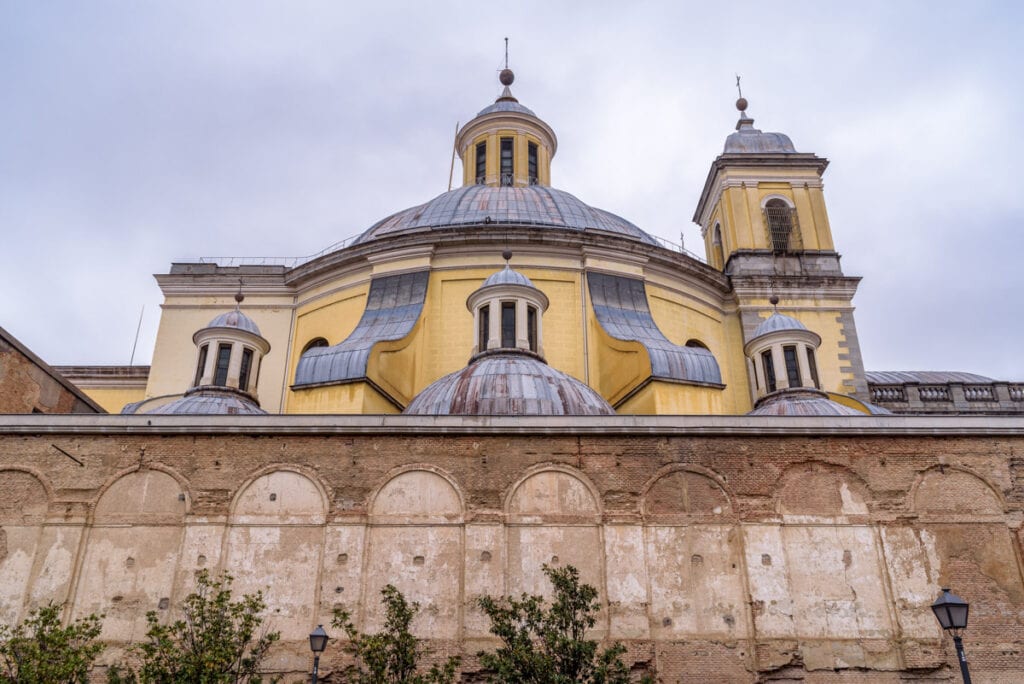
The neighborhood is known for its tapas bars, especially along Calle Cava Baja and Calle Cava Alta. These streets are perfect for a tapas crawl for lunch or dinner!
Casa Lucas is a must visit, but be prepared for crowds. At Los Huevos de Lucio, be sure to order the fried eggs with fries!
On Sundays, El Rastro, the famous flea market, takes over Calle Ribera de Curtidores and nearby areas. It’s super crowded, so arriving early, around 9 a.m., is your best chance of having a less boisterous experience. And keep your belongings close!
Visit the Museo Reina Sofia
While the Prado is the pre-eminent museum of traditional Spanish art in Madrid, the Reina Sofia (officially the Museo Nacional Centro de Arte Reina Sofía) is the museum to visit for its superb collection of 20th century Spanish art.
You’ll find extensive collections of the works of Pablo Picasso and Salvador Dali here, with Picasso’s Guernica the most famous work in the collection.
Also look for works by other Spanish artists like Joan Miró, Juan Gris, and Pablo Gargallo, and works by international artists such as Henry Moore and Diego Rivera.
Picasso’s Guernica is the most famous work in the collection.
The museum also features temporary exhibits featuring Spanish and international artists.
The Reina Sofia is closed Tuesdays. Check hours and buy tickets at the museum website.
You can also buy tickets online at GetYour Guide, or book a guided tour for commentary on the art you will see.
Stroll the Royal Botanic Gardens
The Real Jardín Botánico are located between the Reina Sofia and the Thyssen, making the gardens a great green break between the two art museums!
Spread over 20 acres, the gardens were established in the mid 18th century and moved to their present location a few years later.
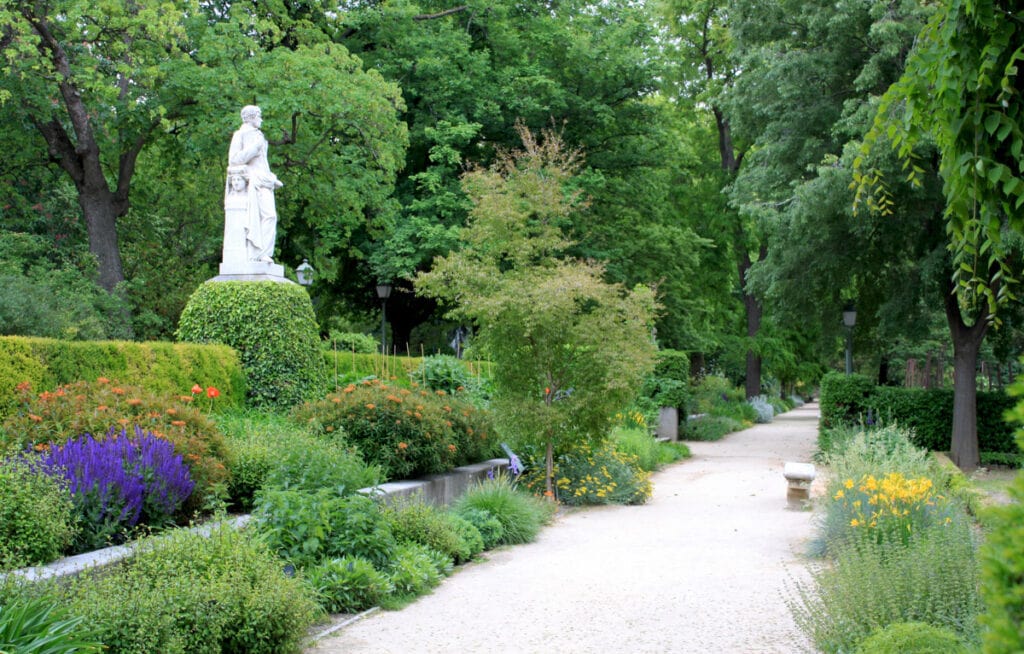
With seven outdoor sections and five greenhouses, the Royal Botanical Gardens are home to close to 100,000 plants and 1,500 trees. The herbarium here is the largest in Spain.
You’ll find ornamentals here, as well as medicinal and aromatic plants. Many plants were brought back from Spain’s colonies overseas.
Enjoy strolling the pathways to admire the horticultural specimens and snap photos of flowers in bloom.
The gardens are open everyday except Christmas and New Year’s Day. There is a modest admission fee.
Take in More Art at the Thyssen Museum
Completing Madrid’s Golden Triangle of Art is the Thyssen-Bornemisza National Museum, also known simply as the Thyssen.
The collection here contains both traditional and modern art, spanning the period from the 13th until the 20th century. Over 1,000 works of art are included in the permanent collection.
You’ll find works here by masters from many countries, including Italy, Germany, and America. Look for Jan Van Eyck, Caravaggio, Rubens, Monet, Degas, Chagall, Rembrandt, Van Gogh and more here.
Its variety is definitely a draw. We loved this museum!
The Thyssen is open everyday, but on Monday it has shortened hours. Check hours and buy tickets at the museum website. Or book a guided tour.
Pro Tip: If you want to see the highlights of all three of the above art museums in Madrid, you can get a combined ticket, or book a guided tour that takes you to all three museums.
Take a Tour of the Bernabeu Stadium
Fans of football will want to schedule a visit to the Santiago Bernabéu Stadium, home of the Real Madrid team since 1947.
Learn about the history of the famous club, and view significant moments from past events on interactive screens set throughout the stadium.
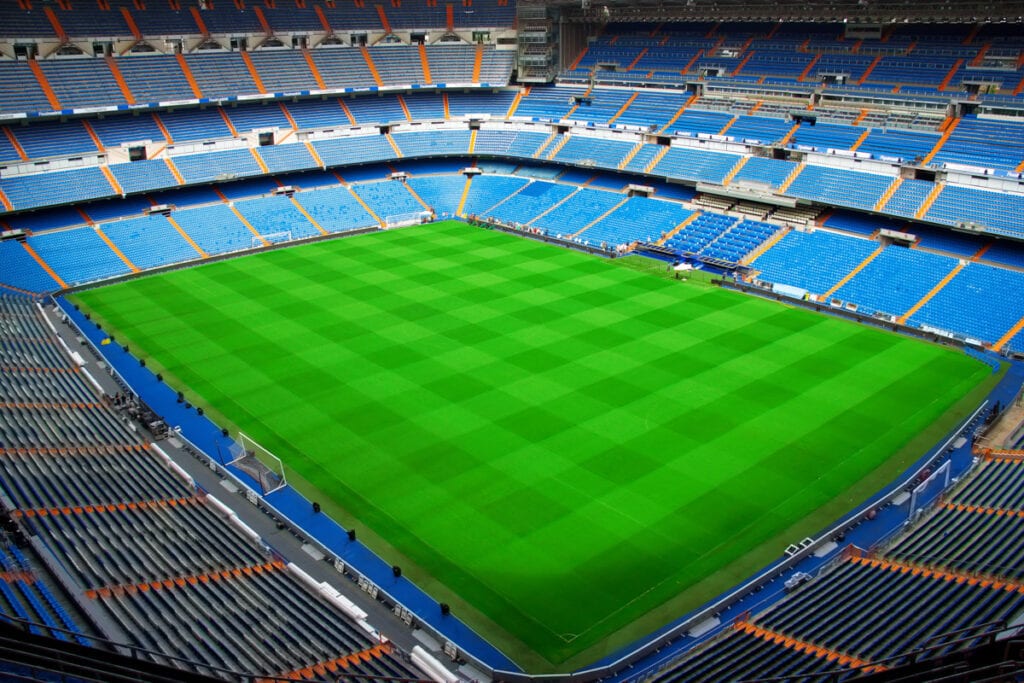
Visit the museum, where you can view team trophies and other significant memorabilia. You can also visit a viewpoint from where you get an expansive view of the stadium.
At the time of writing, an expansion project is under way, but tours of the stadium are still being offered.
Guided tours last about one hour. Buy tickets online at the Real Madrid website.
You can also buy Bernabeu Stadium tour tickets online at GetYourGuide.
Discover the Malasaña Neighborhood
A vibrant (but grittier) neighborhood, Malasaña makes for a wonderful wander.
Streets are lined with striking buildings, lots of vintage clothing shops, cafes, restaurants, and bars. You’ll find street art to photograph, and the people watching is excellent!
Be sure to step inside the Iglesia de San Antonio de Los Alemanes, a small Baroque church that’s beautifully decorated inside. There’s a small fee, but the frescoes inside are well worth the fee!
If you’re hungry, you’ll want to visit the Mercado de San Ildefonso, where you can find not only Spanish food stalls, but also Central American and South American stalls.
And if you’re in the mood for a bit of sightseeing, tour the beautiful Palacio de Liria, where the art on display includes works by Goya, Velázquez, Zurbarán, El Greco, Ribera, Murillo, Rubens and Titian.
Enjoy a Flamenco Show
A flamenco performance is a great way to close out your three days in Madrid. The colorful costumes, intricate footwork, rhythmic clapping, and haunting music will captivate you.
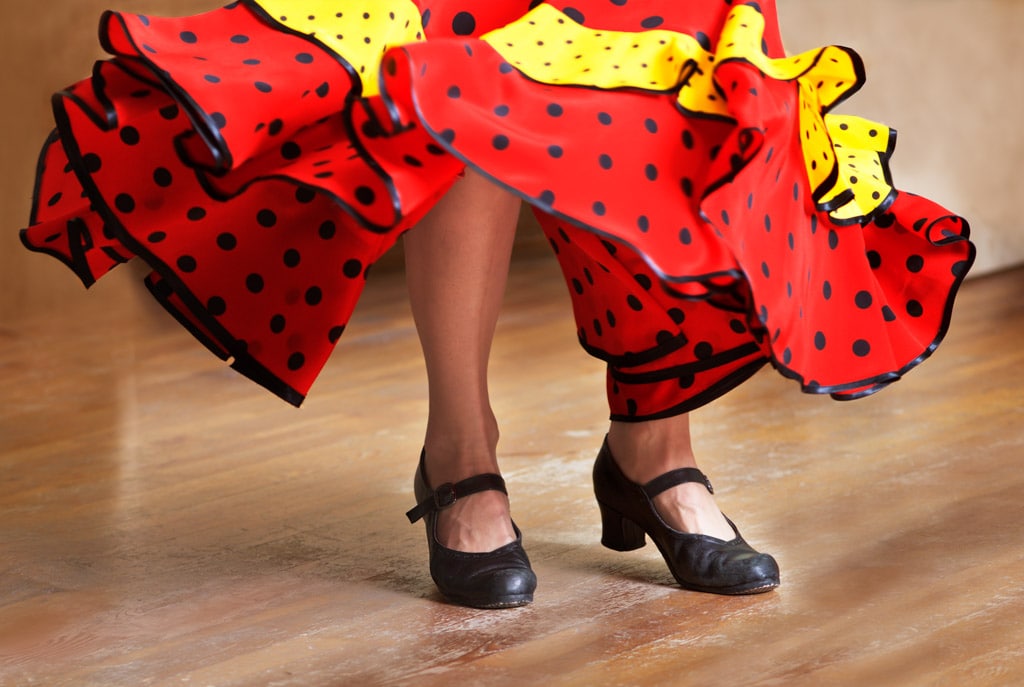
Emociones at the Teatro Flamenco Madrid is very popular. The one-hour performance showcases the art of flamenco in an intimate setting.
Corral de la Moreria is a historic Madrid tablao that has featured performances by renowned flamenco artists, although currently their own troupe performs here.
There are two eateries at the club, one of which has a Michelin star! Both eateries are helmed by Chef David Garcia.
This popular show also comes with food and drink options. Torre Bermejas is a well-known Madrid tablao, with a stunning setting based on the Alhambra of Granada.
You can choose just the show, the show and a drink, or the show and a meal (several choices, including a vegan option).
This one-hour traditional flamenco show is another option. The setting is a cultural center, an intimate theater where the show is performed without a microphone.
Take a Day Trip to Toledo
If you’d rather spend your full third day in Madrid, or a part of it, exploring outside the Spanish capital, consider a trip to Toledo.
The historic hilltop city of Toledo is just 32 minutes from Madrid by train, making it perfect for a day trip. It is designated a UNESCO World Heritage Site and the historic center makes for a great visit.

If you plan to visit independently, book the Hop On, Hop Off tour, which stops at a couple of viewpoints from where you can snap fabulous photos of Toledo.
In the historic center, snap photos of the majestic Alcazar, perched at the highest point in the city, step inside the Toledo Cathedral and the Monasterio de San Juan de Los Reyes, walk the historic Puente de Alcantara and the Puente de San Martin, and enjoy the lively Zocodover Square.
If you’d rather tour Toledo with a guide, book this guided tour that includes two options: 5.5 hours or 9 hours. You’ll get to stop at the panoramic viewpoints and enjoy a guided walking tour of the historic center.
Want to visit more than one historic city on your day out from Madrid? This popular guided tour takes you to Segovia and Avila, and this highly-rated tour helps you visit Toledo and Segovia, with an option to add Avila.
We have an in-depth article on day trips from Madrid if you’d like to flesh out your many choices!
Getting to Madrid
For travelers from the US, Madrid is often the best place to fly into and out of Spain.
Madrid-Barajas Airport is the major international airport that serves the city.
Madrid is also well-connected by train to many other cities within Spain. You can also arrive by train from France or Portugal.
The city is also served by an inter-city coach system, and, of course, you can drive to Madrid if you are on a road trip.
Madrid-Barajas Airport is 17 kilometers (about 10.5 miles) from the city center.
If you have lots of bags, you can arrange for a private transfer or take a taxi.
Of the two options, we suggest a pre-arranged transfer, because the taxi fare system can be confusing if your destination is not within the 30-euro flat fee structure.
Plus, you’ll get an English-speaking driver should you need one, and flight monitoring for possible delays.
If you are traveling light, you can opt for the metro, or the Airport Express bus into the city center.
There are metro stations at the airport at Terminals 2 and 4. You may have to transfer to get to your final destination.
The Airport Express bus stops at the Plaza be Cibeles and then at the Atocha train station. The bus runs everyday and the journey takes about 40 minutes each way.
We’ve taken this bus a couple of times and found it very convenient, especially if you choose accommodation that’s central.
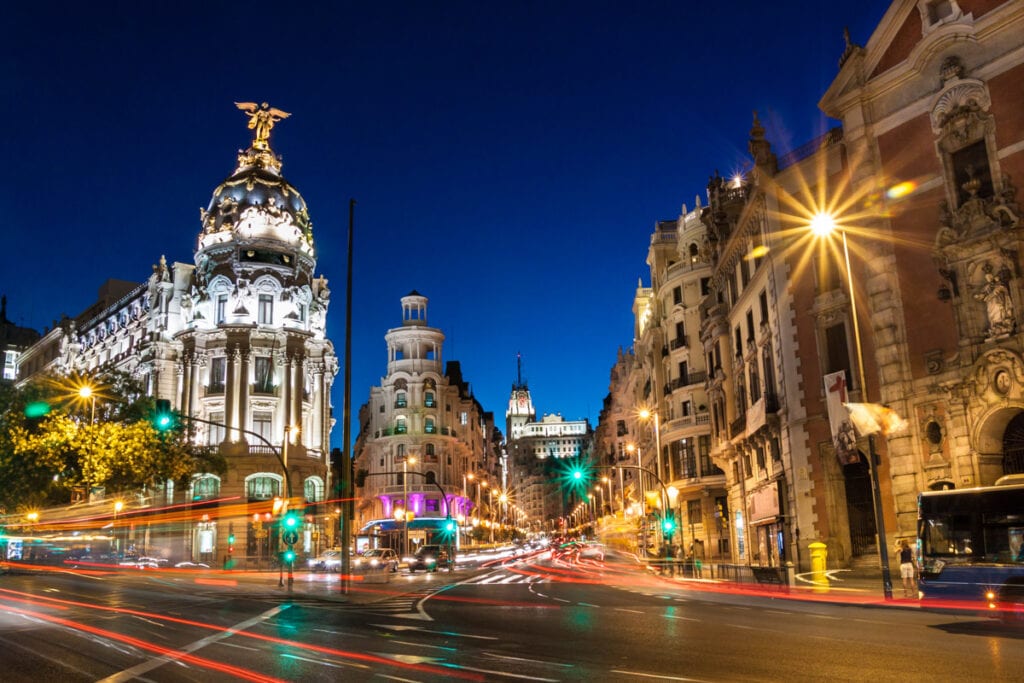
Getting Around in Madrid
If you stay in the historic center (which we suggest you do!), many sights are within walking distance.
If you are looking for other transport options, Madrid offers a plethora of choices.
You can rent bikes, take the metro (super convenient!), taxi, bus, or local/suburban trains. While you can drive, we suggest parking your car and using public transport for destinations you can’t reach easily on foot.
The city offers a Tourist Travel Pass that allows for unlimited use of public transport options for the time period and zones your ticket covers.
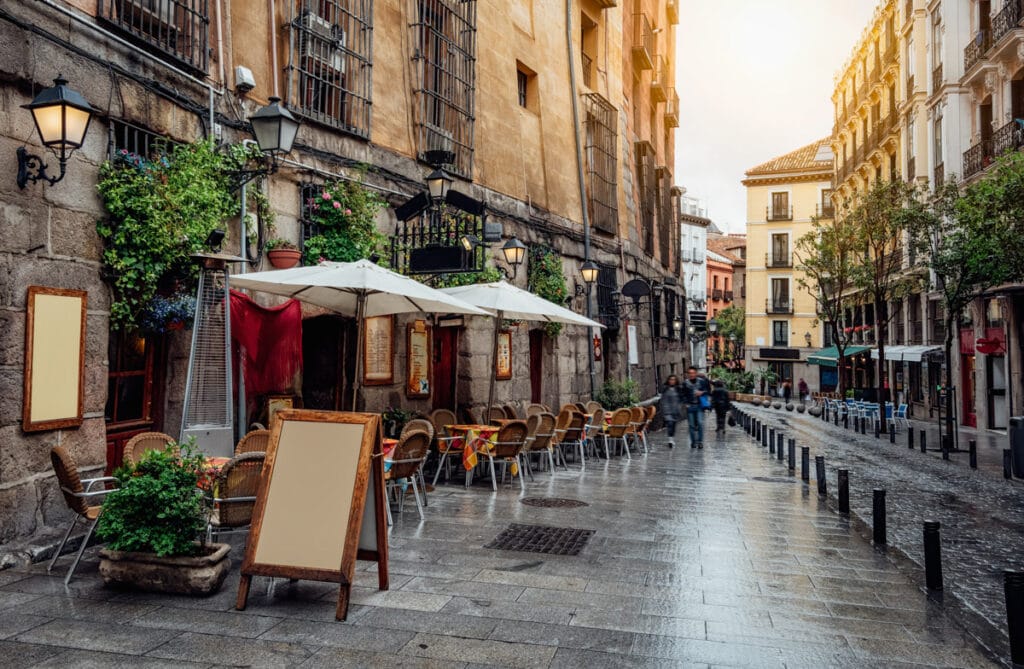
Where to Stay in Madrid
Luxury Hotels in Madrid
The Mandarin Oriental, Ritz Madrid is located by Retiro Park and Madrid’s art museums. Housed in a Belle Époque palace, the hotel offers luxurious individually decorated rooms and suites. Furnishings are classic-contemporary.
The wellness center boasts an indoor swimming pool, a vitality pool, experience showers, and a steam room.
Check rates and availability now!
Palacio de los Duques Gran Meliá is located near the Royal Palace and the Cathedral, and is housed in a 19th century palace. The hotel has a gorgeous seasonal rooftop pool, a terrace with panoramic views, and a lush garden.
Rooms and suites are sumptuously appointed, and there is a Thai Room wellness center and several onsite restaurants.
Check rates and availability now!
Mid-Range Hotels in Madrid
Posada del Dragon is a boutique property located in La Latina, just 350 feet from the Plaza Mayor. You can splurge on all the tapas you want at the many tapas bars here!
The historic hotel offers modern rooms with colorful decor. Rooms feature soundproofing for restful sleep.
Check rates and availability now!
Only YOU Boutique Hotel is housed in a restored 19th century palace, and located in the lively Chueca neighborhood. It is walking distance to major sights and gets rave reviews on Tripadvisor.
The individually decorated rooms feature modern furnishings, and rooms are soundproofed.
Check rates and availability now!
Dear Hotel Madrid is a boutique hotel located along Calle Gran Via, near the Plaza de Espana. The restaurant and lounge features a terrace with panoramic views over the city.
Soundproofed rooms are well appointed and breakfast is very highly rated.
Check rates and availability now!
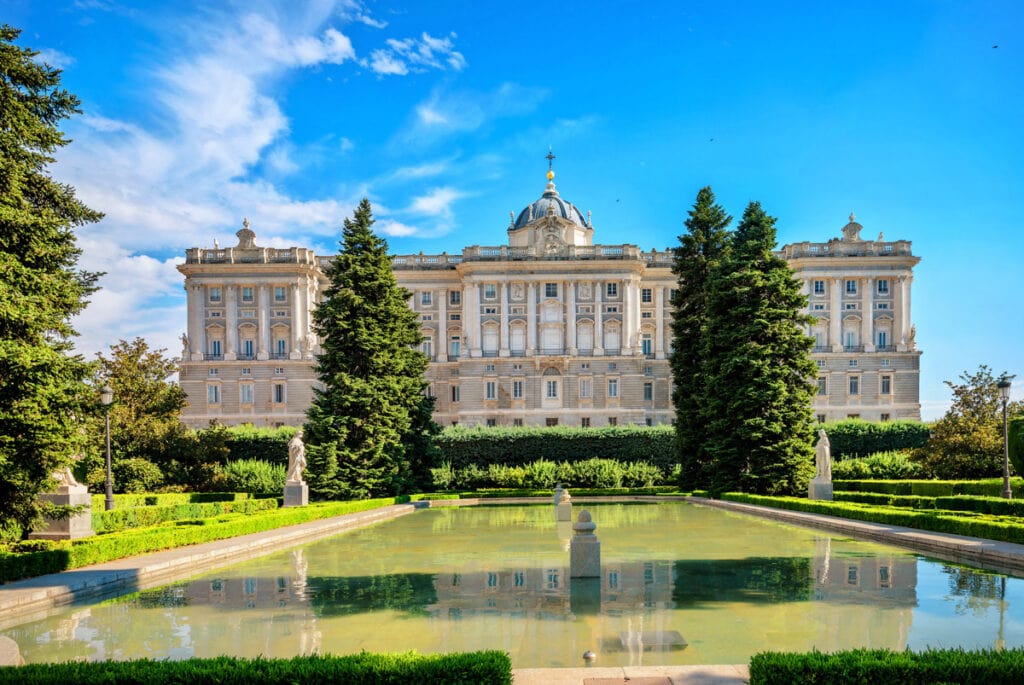
The Best Time to Visit Madrid
Spring and fall are without question the best times of year to visit Madrid.
In the spring, you’ll find pleasant daytime temperatures (highs in the low 60s to low 70s Fahrenheit), and gardens and green spaces look beautiful, especially later in the spring.
Madrid celebrates Semana Santa (Easter) generally in March. If you visit during this time, expect the city to be more crowded, as it’s a time for locals to get together with family and friends. There are numerous processions that take place during the celebrations.
In the fall, the parks in the city look stunning, with brilliant leaf color. Temperatures are pleasant and perfect for wandering about outdoors, especially in early fall.
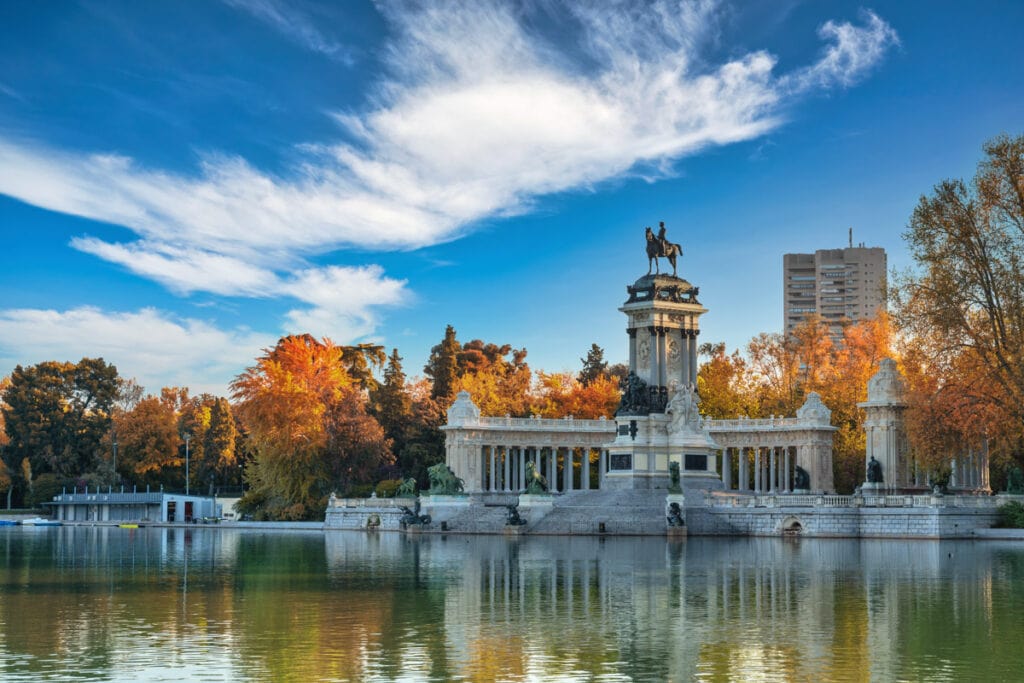
In the summer, Madrid can get somewhat uncomfortably hot, with daytime temperatures in the high 80s or more. You’ll have long daylight hours, though! If you plan a summer trip to Madrid, you’ll want to schedule indoor sights for the hottest part of the day.
In the winter, Madrid gets fairly cold, with highs in the 30s in January. But if you are prepared for the cold with warm attire and want to score a great deal on accommodation, plan a winter trip to Madrid!
Bring layers and rain gear, regardless of when you plan to visit!
Madrid: Frequently asked Questions
3 days in Madrid is the perfect amount of time to take in the major attractions like the Royal Palace and El Prado, explore Madrid’s beautiful green spaces, like El Retiro, and savor the ambience in the many vibrant neighborhoods, such as La Latina.
You can also take a tapas tour and enjoy a flamenco show.
Both Madrid and Barcelona are must-visit cities in Spain. You’ll find many more international visitors heading to Barcelona, but we love the vibe of Madrid: it feels like a city for its residents, not just for tourists.
Art lovers will find unmissable treasures in Madrid’s Golden Triangle of Art. Sun and sand aficionados will love the beaches in and around Barcelona, and fans of Gaudi will definitely want to tour his many works in Barcelona.
Both cities offer great ambience and fabulous food and drink. Frankly, we’d put both cities on our Spain itinerary!
That totally depends on you…how slow you like to travel, whether you want to visit all three of the top art museums, and how many day trips from Madrid you want to include in your itinerary.
We’ve visited three times so far, once for just one whirlwind day, once for 3 days, and once for 5 days, so we could explore some of the day trip options.
Without a doubt, YES!
Madrid’s gorgeous art and architecture will captivate you, whether you are at the Royal Palace, the Prado, strolling Gran Via, or enjoying the ambience in one of many squares in the historic center.
The city’s many parks and gardens are great for strolling, and its tapas bars a great way to sample the multitude of delicious dishes on offer.
The historic core of Madrid is quite walkable, and that’s where many of the major sights you’d want to see on your first visit are located.
As long as you find accommodation in the heart of the historic core, you can pretty much walk everywhere once you arrive in the city center.
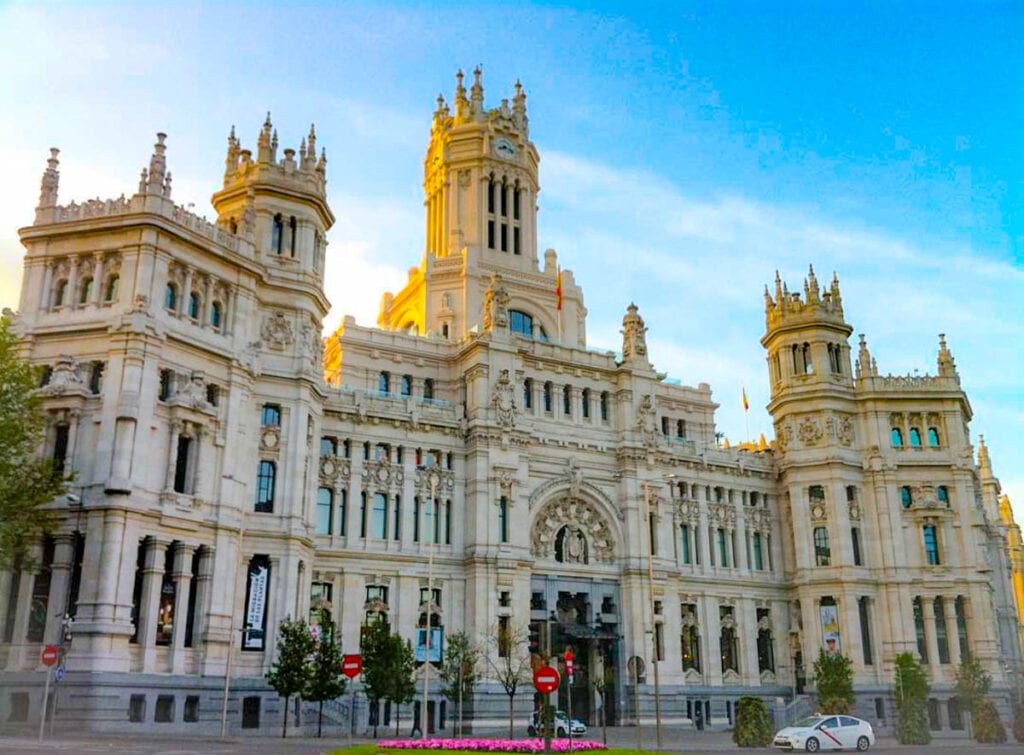
More Spain Travel Inspiration
Planning a trip to Spain? Check out our 10 days in Spain itinerary, especially geared toward first-time visitors to the country.
If you are considering a return visit, we also have a round-up of the best places to visit in Spain, and the most compelling Spain road trips to consider.
Barcelona is of course a favorite destination in Spain, and we have an epic 3-day itinerary for Barcelona, but add a few days to your planned time in the city to take some day trips from Barcelona. We have an in-depth guide on taking a day trip to Girona from Barcelona.
If you are planning a trip to Southern Spain, we have a detailed itinerary for Andalusia you’ll want to check out! It includes Seville, Granada, Malaga, Ronda, and Cordoba.
Many visitors have the Alhambra of Granada at the top of their wish-list for Spain. And no wonder! Exploring the breathtaking Nasrid Palaces and Generalife Gardens at the Alhambra are among the best things to do in Granada.
Seville is one of our favorite destinations in Spain. Read our 3 days in Seville itinerary if you are planning your first trip, or our one day in Seville guide if your visit will be a quick one.
We also have an article on the best things to do in Seville, as well as a guide to Seville in winter.
Also be sure to peruse our in-depth guide to the Real Alcazar of Seville, one of the top monuments to visit in Andalusia.
Check out our suggestions for day trips from Seville, as well as a detailed guide to planning a day trip from Seville to Cordoba.
If you are trying to decide whether to visit Granada or Seville, we suggest you allow for enough time to visit both! But we have an article to help you choose if you only have time for one or the other.
Visiting the Mezquita is only one of the many wonderful things to do in Cordoba, which served as a filming location for Game of Thrones.
Ronda is one of the most picturesque white villages in Spain, and our one day in Ronda guide describes all the best things to do in the hilltop city. Another Andalusian pueblo blanco to consider is gorgeous Casares.
You can visit both Ronda and Casares on day trips from Malaga, the Andalusian city located on Spain’s Costa del Sol. There are many exciting things to do in Malaga as well.
Did you find this article informative? Pin it for later reference!
